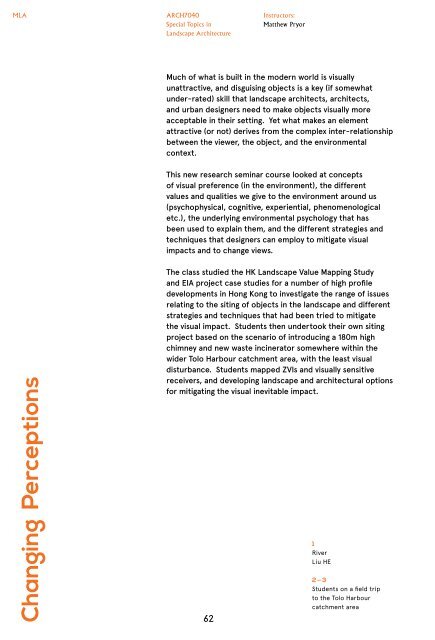HKU-Landscape-Annual-2013-14
HKU-Landscape-Annual-2013-14
HKU-Landscape-Annual-2013-14
You also want an ePaper? Increase the reach of your titles
YUMPU automatically turns print PDFs into web optimized ePapers that Google loves.
MLA<br />
ARCH7040<br />
Special Topics in<br />
<strong>Landscape</strong> Architecture<br />
Instructors:<br />
Matthew Pryor<br />
Special Topics in<br />
<strong>Landscape</strong> Architecture<br />
Much of what is built in the modern world is visually<br />
unattractive, and disguising objects is a key (if somewhat<br />
under-rated) skill that landscape architects, architects,<br />
and urban designers need to make objects visually more<br />
acceptable in their setting. Yet what makes an element<br />
attractive (or not) derives from the complex inter-relationship<br />
between the viewer, the object, and the environmental<br />
context.<br />
This new research seminar course looked at concepts<br />
of visual preference (in the environment), the different<br />
values and qualities we give to the environment around us<br />
(psychophysical, cognitive, experiential, phenomenological<br />
etc.), the underlying environmental psychology that has<br />
been used to explain them, and the different strategies and<br />
techniques that designers can employ to mitigate visual<br />
impacts and to change views.<br />
1<br />
Changing Perceptions<br />
The class studied the HK <strong>Landscape</strong> Value Mapping Study<br />
and EIA project case studies for a number of high profile<br />
developments in Hong Kong to investigate the range of issues<br />
relating to the siting of objects in the landscape and different<br />
strategies and techniques that had been tried to mitigate<br />
the visual impact. Students then undertook their own siting<br />
project based on the scenario of introducing a 180m high<br />
chimney and new waste incinerator somewhere within the<br />
wider Tolo Harbour catchment area, with the least visual<br />
disturbance. Students mapped ZVIs and visually sensitive<br />
receivers, and developing landscape and architectural options<br />
for mitigating the visual inevitable impact.<br />
1<br />
River<br />
Liu HE<br />
2 — 3<br />
Students on a field trip<br />
to the Tolo Harbour<br />
catchment area<br />
62 63<br />
2<br />
3


